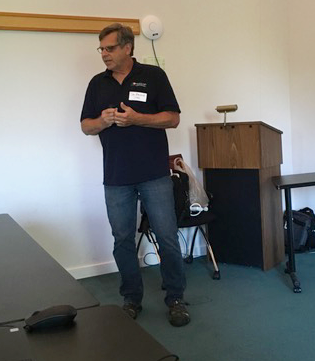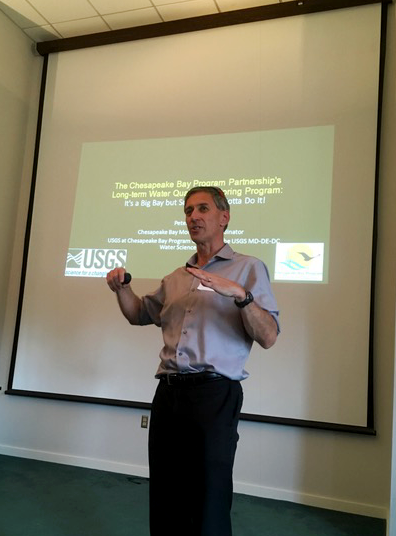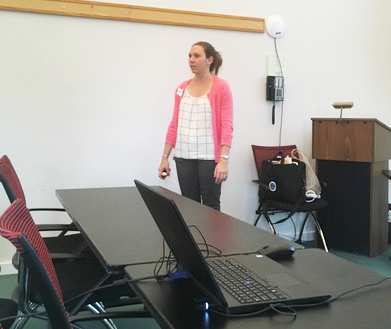Developing environmental intelligence through environmental literacy and citizen science
Bill Dennison ·I was asked to speak at a ‘Data to Decisions’ workshop at the Wye Research and Education Center on the summer solstice (21 June 2017). The workshop was sponsored by the Maryland Water Monitoring Council (MWMC). Caroline Donovan, the Integration and Application Network’s (IAN) Program Manager, is on the MWMC board and is also the lead IAN representative on the Chesapeake Monitoring Cooperative. The workshop was attended by various Riverkeeper and Waterkeeper groups from both the western and eastern shore of Maryland.

The focus of my talk was on building environmental intelligence. First of all, I defined what I meant by environmental intelligence. Environmental Intelligence can be defined as 1) The ability to acquire and apply environmental knowledge and 2) The collection of information of environmental value. The word ‘environmental’ stems from a French word ‘environ’ which means ‘surrounding’. The word ‘intelligence’ stems from a Latin word ‘intelligere’ which means to comprehend or perceive. Thus, another definition of environmental intelligence can be 3) The ability to perceive your surroundings.

I contrasted the term ‘environmental intelligence’ with monitoring. The word monitoring focuses on the data collection aspects of gathering environmental intelligence. ‘Monitor’ stems from the Latin ‘monere’ which means warned. Monitoring is defined as 1) Observe and check the progress or quality of something over a period of time, or 2) Keep under systematic review. While this word does accurately portray an important aspect of environmental research and management, it has become associated with mindless repetition of data collection and has become increasingly difficult to justify and maintain funding support. In many programs, the monitoring data rarely sees the light of day, residing in databases that are repositories rather than interactive databases that are regularly interrogated and used in environmental decision making. Thus, building environmental intelligence is the term I promoted to this group.

There are several aspects of environmental intelligence that IAN promotes. One aspect is the establishment of environmental literacy principles. When we begin a project in a new region, the first thing we assemble is a series of key factors that are essential in order to understand the ecosystem. For example, the seven environmental literacy principles for Chesapeake Bay are the following:
- Chesapeake Bay is a large, shallow and productive estuary formed by a drowned river valley.
- The extensive Chesapeake watershed is connected to the Bay by a myriad of streams and rivers.
- Chesapeake Bay is particularly vulnerable to runoff of nutrients, sediments and toxicants.
- Climate change and land use alteration are major drivers for Chesapeake Bay and its watershed.
- Chesapeake Bay supports unique human cultures and livelihoods.
- American history has been shaped by Chesapeake Bay.
- Chesapeake Bay has been extremely well studied and intensively managed.

Another aspect of environmental intelligence that IAN promotes is the use of environmental report cards. The synthesis of various data into report card scores for subregions within a geographic area provides a readily understood assessment of ecosystem health. Since report cards use rigorous data and analyses, yet are easy to understand, they draw significant media attention. This promotes a wide dissemination and helps to build community knowledge about the status and trends of a particular region. The number of environmental report cards that are developed by various watershed groups has greatly expanded in the Chesapeake region.
There is a large difference between scientific knowledge locked up in universities and agencies versus the community knowledge held by non-experts. The scientific publishing enterprise often prevents citizen scientists or community groups from accessing scientific publications due to a ‘paywall’. University and agency libraries pay for subscription services to obtain scientific journal articles so that their scientists can access the articles. However, the prohibitive costs for people outside of academia or agencies means that the papers remain essentially hidden behind the ‘paywalls’. Environmental intelligence needs to be widely held by the broader community to be effective.

Under the administration of Governor Martin O’Malley, we essentially provided him with monthly environmental intelligence briefings through his BayStat initiative. Under other Maryland governors, we used regular Bay Cabinet meetings with cabinet secretaries to provide the environmental intelligence briefings.
There were a series of good talks following my opening remarks; Beth Wasden (Nanticoke Watershed Alliance), Dan Boward (Maryland Department of Natural Resources), Matt Stover (Maryland Department of Environment), Peter Tango (USGS at the Chesapeake Bay Program) and Liz Chudoba (Chesapeake Monitoring Cooperative). Two of the talks referred to song lyrics, which, somewhat predictably, inspired me to write some song lyrics. Beth Wasden used the term ‘rock star’, referring to citizen scientists and included a line from the rock and roll band ‘Kiss’ which was the following: “I want to volunteer all night and Creekwatch all day”. This inspired the following lyrics:
I want to volunteer all night
21 June 2017
William C. Dennison
You show us all the data you've got
You keep on samplin’ and the issues get hot
You drive your boat, the data’ll drive you crazy
You say you wanna go for a spin
The TMDL’s just begun; we’ll let you in
You drive your boat, the data’ll drive you crazy
You keep on sampling, you keep on shoutin’.
I want to volunteer all night and Creekwatch all day!
I want to volunteer all night and Creekwatch all day!
You keep on saying you’ll sample for a while
You’re looking sharp and I like your style
You drive your boat, the data’ll drive you crazy
You show us all the data you’ve got
And you drive your boat, the data’ll drive you crazy
You keep on samplin’, you keep on shoutin’.
I want to volunteer all night and Creekwatch all day!
I want to volunteer all night and Creekwatch all day!
The title of Matt Stover’s talk was ‘Take a Walk on the Regulatory Side’, based on the Lou Reed song ‘Walk on the Wild Side’. Becky in the song refers to Matt’s colleague Rebecca Lang at MDE (Maryland Department of Environment). The lyrics are as follows:
Take a Walk on the Regulatory Side
21 June 2017
William C. Dennison
Matt Stover came from the MDE
Hitch-hiked his way across the state
Created his powerpoint on the way
Brought along his poster and then he shared his maps
He said, hey babe, take a walk on the regulatory side,
Said, hey honey, take a walk on the regulatory side.
Becky came from Montgomery Park,
In the conference room she was everybody's darling,
But she never lost her head
Even when she was listening to Matt
She says, hey baby, take a walk on the regulatory side
Said, hey babe, take a walk on the regulatory side
And the river keepers go,
Doo doo doo doo doo doo doo doo doo
Doo doo doo doo doo doo doo doo doo
I was impressed that the audience joined in with the refrain. It was a nice evening shared with interesting and committed environmental heroes.
About the author
Bill Dennison

Dr. Bill Dennison is a Professor of Marine Science and Vice President for Science Application at the University of Maryland Center for Environmental Science.

